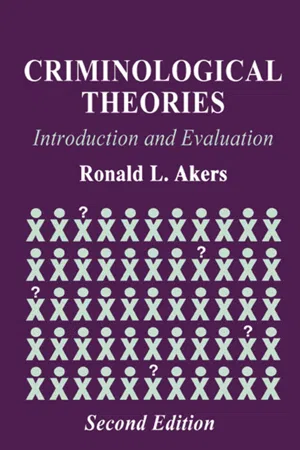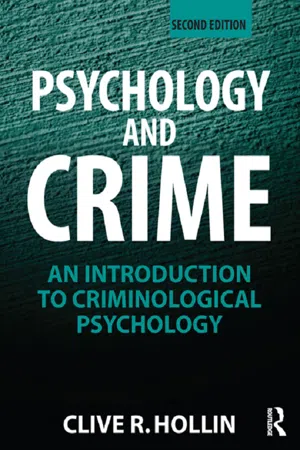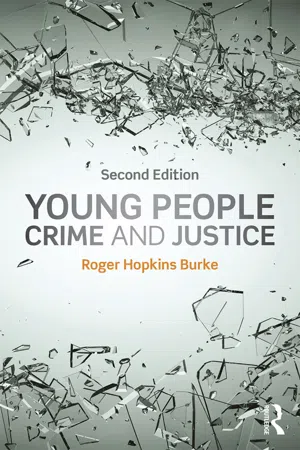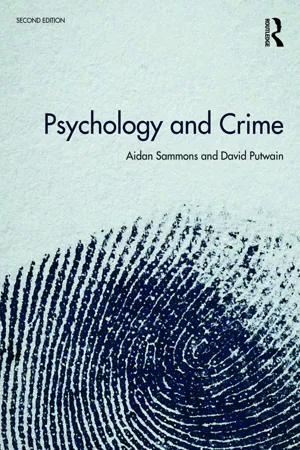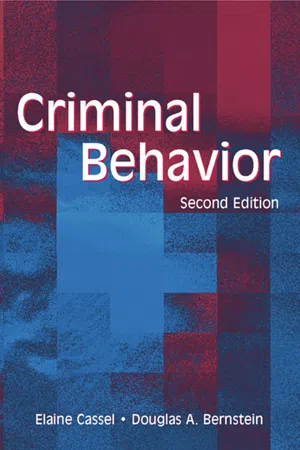Biological Theories of Crime
Biological theories of crime propose that biological factors, such as genetics, brain abnormalities, and hormonal imbalances, contribute to criminal behavior. These theories suggest that individuals may have a predisposition to criminality due to their biological makeup. Research in this area explores the potential influence of genetics, neurobiology, and physiological factors on criminal behavior.
8 Key excerpts on "Biological Theories of Crime"
- eBook - ePub
Criminological Theories
Introduction and Evaluation
- Ronald L. Akers(Author)
- 2013(Publication Date)
- Routledge(Publisher)
...Chapter 3 Biological and Psychological Theories DOI: 10.4324/9781315062723-3 Introduction Social structural and social psychological theories, to be introduced and evaluated in later chapters, either ignore or specifically exclude biological or psychological factors in crime. This is not because such theories assume that biological and psychological factors play no part in human behavior or that individuals are all the same. They focus solely on the social factors in crime with the assumption that biological and personality variations among individuals are more or less within the normal range. Little or no criminal behavior is considered to be directly caused by abnormal physiology or abnormal psychology. Traditional biological theories, on the other hand, take the opposite approach by focusing on anatomical, physiological, or genetic abnormalities within the individual which separate law-breakers into a distinctly different category of persons from the law-abiding majority. In turn, such theories ignore or downplay the effect of social environmental factors in crime. Recent biological theorizing, which emphasizes biological variations within the normal range, has begun to include the interplay of biological, social, and psychological variables in crime and delinquency. Psychoanalytic and personality theories recognize the effects of an individuals experiences, especially in early childhood, on one’s emotional adjustment and the formation of personality traits and types. But such factors are not viewed as the cause of criminal behavior. Criminal behavior results from abnormal emotional adjustment or personality traits residing within the individual. Lombroso and Early Biological Theories The classical school of criminology retained a virtual monopoly on the study of crime until the latter part of the nineteenth century...
- eBook - ePub
- Mark M. Lanier, Stuart Henry, Desire' J.M. Anastasia(Authors)
- 2018(Publication Date)
- Routledge(Publisher)
...In fact, Rafter and other proponents of biological criminological theories predict that “we are on the threshold of a major shift that could lead to various genetic and other biological ‘solutions’ to criminal behavior” (ibid.). In this chapter, we present the basic premises of the search for the causes of crime, outline the historical context under which it evolved, provide illustrative examples of the early and contemporary studies, review some of the latest developments, evaluate findings and assumptions, and provide policy implications. Biological and Positivistic Assumptions To comprehend biological theories, it is necessary to grasp the underlying assumptions about humans that biological criminologists make. The major emphasis of this applied science of criminology is that humans have unique characteristics, or predispositions, that, under certain conditions, lead some to commit criminal acts. In other words, something within the individual strongly influences his or her behavior, but this will occur only under certain environmental conditions. For example, some people seem to behave perfectly normally most of the time, but when they get behind the wheel of a car the slightest inconvenience sends them into an angry rage (James and Nahl 2000). Without the automotive environment, they do not manifest anger. According to biological theory, the same can be true for other offenders. For some, the setting and act together provide a thrill that, according to biological theorists, might satisfy an abnormal need for excitement. For others, the environmental trigger to crime might be alcohol, drugs, or being subjected to authority. For early biological criminologists, the classical theory of crime was intuitive and unscientific speculation. Any significant examination of criminal behavior cannot assume that humans are essentially all the same...
- eBook - ePub
- Ian Marsh, Ian Marsh(Authors)
- 2007(Publication Date)
- Routledge(Publisher)
...CHAPTER 2 Biological Explanations for Criminal Behaviour INTRODUCTION In this chapter we examine the controversy over attempting to explain criminal behaviour in biological terms. We consider the main types of biological explanation for human behaviour that are used within the subject of criminology and the evidence that underpins them. Typical biological theories are that some people are more likely to commit violent crimes because of the genes that they have inherited; or that there is more chance of acting in an impulsive way that breaks the law if you have attention deficit hyperactivity disorder (ADHD), because it involves a reduction in activity in a part of the brain that helps us both to control our own actions and to see their consequences. It will be clearer if, before we engage with the criticisms of a biological perspective on criminal behaviour, we set out a very brief outline of why biology must be relevant. Human beings are surely just one species out of the millions of living creatures on the earth. Criminal behaviour is still behaviour even if what is regarded as ‘criminal’ changes over time and place. All our behaviour, thoughts, feelings, etc. are rooted in our biology. Given these points, it must be possible to learn about criminal behaviour by taking a biological perspective. THE DEBATE OVER THE VALUE OF BIOLOGY When the contents of this textbook were first proposed, several criminologists considered the outline. Some thought that a chapter on biology was valuable, but some said that a chapter about biological explanations of criminal behaviour did not belong in a criminology book...
- eBook - ePub
Psychology and Crime
An Introduction to Criminological Psychology
- Clive R. Hollin(Author)
- 2013(Publication Date)
- Routledge(Publisher)
...Given this caveat, the conclusion from the evidence from family, twin and adoption studies suggests that genetic factors do have a role to play in understanding crime. There is general agreement that genetic factors are an important predisposing factor to criminal behaviour but that environmental factors are equally important in understanding how that predisposition may be realised. Thus, it is the interaction between genetic and environmental factors that is crucial in understanding criminal behaviour. The relative contribution of genes and environment remains uncertain and, indeed, may potentially vary from individual to individual. It should be stressed that even given genetic and environmental influences that are favourable to criminal behaviour, the outcome is not inevitable. There are children born to criminal parents who experience adverse environments but do not commit crimes: conversely, there are children with non-criminal parents who experience supportive environments and who do commit crimes. The pathway through which a predisposition to criminal behaviour may manifest itself is uncertain, although a number of possibilities have been advanced at various times. The potential pathways that have been suggested include low intelligence, personality type, learning capability, alcoholism, and other biological factors including neurological and psychophysiological functioning. As we progress through the various theories of criminal behaviour, these various factors will emerge. Further, research looking at the neurophysiological correlates of criminal behaviour has a long association with unusual acts of extreme violence, such as murder by the clinically insane (e.g., Hill & Pond, 1952)...
- eBook - ePub
- Roger Hopkins Burke(Author)
- 2016(Publication Date)
- Routledge(Publisher)
...All three variants, nevertheless, incorporate the same fundamental assumptions, and although each is discussed separately, they become increasingly non-exclusive; for example, biologists came to embrace sociological factors, while at times it is often difficult to differentiate between biological and psychological explanations. This chapter considers the biological variant of the predestined actor model and is divided into three sections. First, there is a consideration of those theories which propose that the young person has been born with a physiological predisposition to commit crime. Second, there is a discussion of altered biological states where criminal behaviour is at least influenced by the consumption of alcohol, drugs or poor diet. Third, there is an examination of socio-biological theories which propose that biological predispositions are activated in different ways in diverse environmental conditions, often dependent on the socialised upbringing of the young person. Physiological constituents and youth criminality Early biological explanations of criminal behaviour have their origins in the work of the Italian school at the end of the nineteenth and the beginning of the twentieth centuries and although these theories were primitive by the standards of today, they significantly established an enduring research tradition that has persisted to this day. Cesare Lombroso (1876) argued that criminals are a physical type distinct from non-criminals with physical characteristics suggestive of earlier forms of evolution. It is an approach considered simplistic and naïve today, yet Lombroso had made an important contribution to the development of criminological explanations by recognising in his later work the need for multifactor accounts that include not only hereditary, but also social, cultural and economic factors...
- eBook - ePub
- Helen Gavin(Author)
- 2018(Publication Date)
- SAGE Publications Ltd(Publisher)
...3 Psychological Approaches to Understanding Crime Key Themes Biosocial theories of crime Social learning theory and crime Psychodynamic theories of crime Evolutionary models of crime Feminist models of crime In many sciences, there are attempts being made to find a unified theory, so far, unsuccessfully. Even in a discipline such as physics, the concept of a unified theory has a seemingly insurmountable barrier to overcome in that two compellingly explanatory theories (general relativity and quantum theory) are totally incompatible. So, it is hardly surprising that the study of mind and behaviour is no exception to such a quest, or such difficulties. The study of crime is no stranger to this desire to discover a global explanation, but we remain with the position of several different perspectives attempting to provide understanding of criminal behaviour within existing psychological frameworks. Psychological explanations of crime suggest that individual differences may make it more likely that some people commit crimes than others. These differences may be due to personality characteristics, biological factors, or social influences. There is therefore a hierarchical set of different perspectives, from the social to the individual, that are useful in understanding the nature of crime and the theories attempting to explain it. Strain theory – social structures exert pressures which may lead an individual to commit crime. Crime and the Role of Society Social theories suggest that crime is an outcome of the breakdown in social structures. This can be either at a structural level, where societal processes affect members of society, or at an individual level, where the experiences of people as they seek ways to satisfy their needs are examined. The first major theorist in this area was Merton, whose 1938 analysis of the relationship between society and the values and behaviour of members of that society was pivotal in the sociological examination of crime...
- eBook - ePub
Psychology and Crime
2nd edition
- Aidan Sammons, David Putwain(Authors)
- 2018(Publication Date)
- Routledge(Publisher)
...In the 1990s there was a resurgence of interest in biological factors and there is now widespread acknowledgement that theories of offending that do not incorporate them are necessarily incomplete. This chapter starts by reviewing evidence for some of the biological differences that have been found between offenders and non-offenders and outlining their putative role in criminal behaviour. There follows a discussion of where these differences may come from, focused on a selection of possible causes: genetics, environmental pollution, traumatic brain injury and adverse childhood experiences. Biological differences between offenders and non-offenders The biological view assumes that an individual’s behaviour is organised by his nervous system, particularly his brain, and criminal acts are a consequence of this. Biopsychology does not claim that there are specific brain areas or processes that cause people, for example, to burgle houses, file false tax returns or assault their spouses. Rather, an offender’s nervous system interacts with social and other environmental influences to give rise to tendencies to behave in particular ways (e.g. aggression) that become criminal acts when they violate the law. Biopsychological research has tended to focus on aggressive crime as it is relatively straightforward to identify (unlike, say, financial fraud), is a pressing social problem and has clear links to the large and well-researched body of biological knowledge about aggression. This makes it an obvious target for researchers wishing to investigate biological influences on offending. Low heart rate One of the most consistent findings in the biopsychology of offenders is that they have a lower heart rate than non-offenders. The association is remarkably robust and is found in children, adolescents and adults and across different cultures (Portnoy & Farrington, 2015)...
- eBook - ePub
- Elaine Cassel, Douglas A. Bernstein(Authors)
- 2007(Publication Date)
- Psychology Press(Publisher)
...5 Psychological Roots of Crime Personality and Crime Learning and Crime Traits and Crime Cognition and Crime Psychodynamics and Crime Personality Disorders and Crime I n chapter 4, we considered biological roots of crime, including the influence of genetic inheritance, the brain and central nervous system, and hormonal and other physiological mechanisms that influence aggression and violence. In this chapter, we introduce the psychological theories that attribute the roots of crime to mental processes that develop as people interact with their families and others. We focus on the major psychological theories of personality and personality development as well as on theories about how people process information, think, learn, and interact with others. We then apply these concepts as we trace the development of crime and mental disorders in chapters 7, 8, and 9. Personality and Crime We begin by looking at psychologists’ efforts to develop theories about what personality is, how it can best be measured, how it develops, and how it might be changed. In describing someone’s personality, people usually employ adjectives such as “friendly,” “kind,” “warm,” or perhaps “difficult,” “hostile” or “insecure.” In doing so, one is trying to summarize the essence of that person’s behavior and attitudes, the characteristics that describe a particular individual. Most psychologists agree that personality consists of the unique patterns of thinking, feeling, and behaving that are relatively constant throughout one’s life and through which one can be compared and contrasted with other people. Where does personality come from? It begins with the biological predisposition to act and respond to the world in particular ways, which psychologists call temperament (Bernstein, Penner, Clarke-Stewart, & Roy, 2006). If you were to visit any hospital nursery and observe newborns for a while, you would soon be aware that they behave differently...
